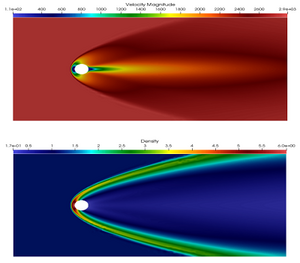Süleyman Cengizci, Ph.D.
Department of Scientific Computing
February 2022
Supervisor: Ömür Uğur (Institute of Applied Mathematics, Middle East Technical University, Ankara)
Co-Supervisor: Tayfun E. Tezduyar (Mechanical Engineering, Rice University, USA; Faculty of Science and Engineering, Waseda University, Japan)
Abstract
For both military and civil aviation purposes, rockets, missiles, and spacecraft moving at hypersonic speeds are being utilized in recent years. While these vehicles move at speeds five times the speed of sound or more, they experience many extreme physical and chemical conditions during their flight. Because of molecular friction, such high velocities cause very high temperatures, and these high temperatures result in the excitation of the components of the gas mixture in which the vehicle moves. This situation causes various thermochemical interactions in the flow field and affects the dynamics of the flight. These interactions need to be examined accurately, for both the flight safety and the vehicle reaching the right target at the right time.
Wind tunnel experiments are both costly and insufficient to regenerate the high temperatures and shock interactions of hypersonic flights. These wind tunnel setups can also take a long time to design, test, and finally obtain the experimental data with. There- fore, computational fluid dynamics (CFD) tools are essential in analyzing the flight dynamics of hypersonic vehicles and designing them for such high speeds. Classical discretization methods need to be supplemented with stabilization and shock-capturing techniques since they suffer from spurious oscillations in simulating such high-speed flows.
In this thesis, hypersonic flows in thermochemical nonequilibrium are computationally studied. To this end, hypersonic flows of a five-species (O, N, NO, O2, N2) gas mixture around a cylinder are examined with a 17-reaction chemical model. The gas particles may be in different energy modes in hypersonic regimes due to the high temperatures: translational, rotational, vibrational, and electron-electronic. Since they have the similar time scales to reach equilibrium, the translational and rotational energy modes can be represented by one temperature, and the vibrational and electron-electronic energy modes by another. Therefore, a two-temperature chemical kinetic model is adopted.
In the computations, the compressible-flow Streamline-Upwind/Petrov–Galerkin method is employed to stabilize the finite element formulation. The stabilized formulation is supplemented with the YZβ shock-capturing to obtain good solution profiles at shocks. The nonlinear system of equations resulting from the space and time discretizations is solved with the Newton–Raphson nonlinear iterative process and ILU-preconditioned generalized minimal residual (GMRES) iterative search technique. The solvers are developed in the FEniCS environment.
Keywords: Inviscid flow, Hypersonic flow, Finite elements, Compressible-flow SUPG, Shock-capturing, Thermochemical nonequilibrium
